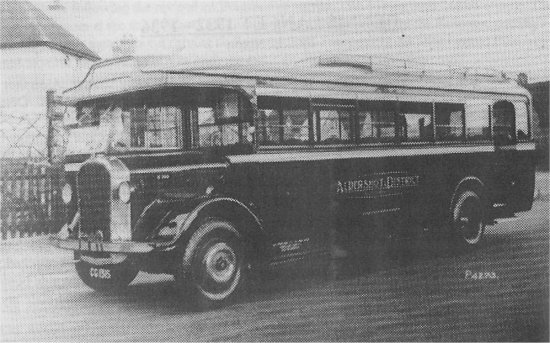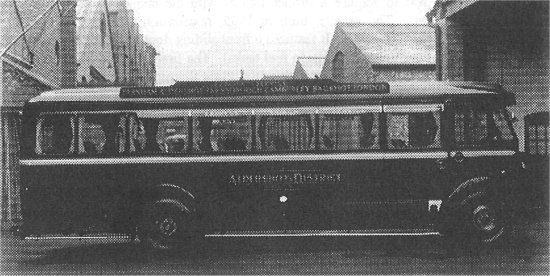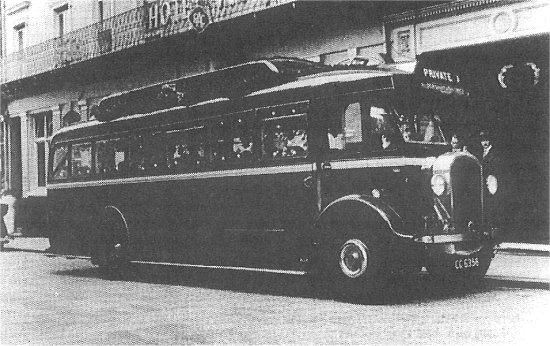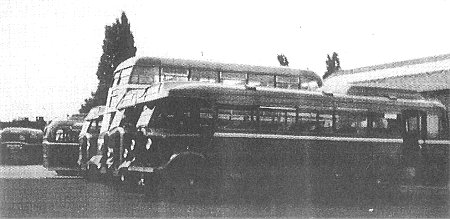|
Following a period of buying Tilling-Stevens chassis in the early thirties, Aldershot & District returned to Dennis Brothers for their future single deck chassis requirements. Dennis had introduced a new 4 cylinder side valve petrol engine chassis with four-speed gearbox. This was primarily designed for single deck bodywork but was also available as a basis for trucks and fire engines. Designed primarily for forward control it was lower in height than the earlier EV model and was priced around £552. The chassis had a large aluminium coffin shaped radiator flanked by mudguards, which tapered forwards at the front edge where they were bolted to a steel bumper bar, which straddled the radiator close to the bottom. A flat chrome strip was fixed to the front of the bumper. The lower section of the steering column was encased in a metal tube, which protruded through the lower section of the dash panel this in turn connected up with the steering drop arm. A one-gallon autovac tank was attached to the bulkhead just under the front passenger window. No louvres were fitted to the side bonnet panel: instead a wire mesh grill was provided. For the first time large dinner-plate style chrome discs were fitted to the front wheels. In 1932 A&D were to acquire the seventh chassis produced, CG 477, and this was despatched to Strachans to be fitted with a 32 seat bus body. Shortly afterwards two more chassis were acquired and fitted with identical bodies, they were registered CG 1315/16. The bodies were of 6 bay construction as fitted to the last Tilling-Stevens chassis but with a number of minor differences. The main modification was that all were fitted with floating cabs. The cab was a separate unit set back approximately 2 inches from the-body on the offside, and was secured to the main body by canvas strips screwed into position. The destination display consisted of a place and via destination placed one over the other and mounted in the full width canopy. The usual number box was fitted in the top corner of the front passenger's window. A single line destination was built into the rear dome centrally over an oblong rear window. The rear number plate was painted on an oblong metal plate fixed to the lower panel of the offside and was flanked by a rear lamp. An extra rear lamp was fitted into the offside dome, level with the rear window. This light was not fitted with a bulb, since there was a clear glass in line with this on the inside of the dome. When the interior lights were switched on the light would filter through. A steel rod roof rack was fitted which could be reached by four pullout chrome steps and a small length of ladder. The lower side panels were much deeper them earlier vehicles, making it possible to do away with one of the lifeguard rails on each side. A porch type door was situated just behind the nearside rear wheel. All the seats were forward facing except for two three-person bench seats facing inwards and bolted to the rear wheel arches. Seats were trimmed in grey check cloth material as were the side casing panels. Dark wood fillets surrounded the windows and also the bulkhead. Two imitation Olympic torches were set at an angle on the front bulkhead flanked by two round mirrors plus a third mirror being placed in the centre. There were also Olympic type torches fitted into the rear domes, one either side of the destination box. The torches were approximately twelve inches in length, the stem being chrome plated, with an imitation flame made of frosted glass which could be illuminated at night. An old type cord bell was employed, and also cord type luggage racks were fitted.
Later the same year a further 12 Lancets were delivered. CG 1317-28, these being 30 seat coaches. They differed in a number of ways. The top destination was use while the underneath one was painted green and lettered with the Aldershot scroll in gold. No rear destination was carried. The rear window was much deeper, as were the side panels, making it possible to use only one lifeguard rail per side. No roof luggage racks were carried, but some did acquire them at a later date. A hinged door flush with the body side just behind the rear wheel was the means of entry. The doors were replaced by sliding doors just after the war, as on the next two coaches to be delivered. Thirty luxury coach seats trimmed in black and grey material were all front facing, rug rails and ashtrays were fitted to the backs. The seats were arranged in pairs, one being staggered in front of the other giving a single seat to each passenger. A clock replaced the centre mirror, overhead racks were employed with lights underneath. Electric bells and hot water pipe heating were introduced for the first time. Roof boards were carried, along the sides of the roof coves, suitably lettered for the Farnham Express Service. Five bay construction was used and was to remain on all half cab vehicles until the end of production in 1950. The rear number plate was fixed to the offside rear corner and flanked by a rear lamp. Two more coaches, CG 6357-8, were delivered in 1934. These were similar to the previous batch except for a few small details. It is interesting to note that CG 6357 was to appear on the front cover of the Company's timetables longer than any other vehicle. The rear dome was much more rounded and the rear window was much shallower than on the previous batch. A large sheet metal luggage carrier was fitted, stretching from halfway above the first side window to half way above the entrance door, and there were no steps or ladder provided to gain access to the roof A small bracket was fitted centrally to the roof rack on the nearside, this makes me think that a collapsible ladder must have been kept somewhere in the coach to gain access to the roof. Roof boards were carried on the sides of the luggage racks.
In 1935 a further batch of 9 coaches, CG 9596-9603, and CG 9605 were delivered. For some unknown reason registration number CG 9604 was not issued to A&D, but in fact went to Provincial of Gosport who used it on one of their Regal coaches. The 9 coaches were very similar to the previous two but differed in a number of ways. The rear number plate had reverted back to being oblong and mounted on the rear offside panel. The major change was that a sliding door, which slid rearwards into a recessed panel on the inside of the vehicle, replaced the hinged door previously used. All future half-cab vehicles were to employ this feature. In 1936 a batch of twenty-nine 32 seat buses arrived. These were registered AOT 587-605 and BAA 387- 96. The body shape was the same as the coaches, but the major difference was that for the first time, the route number box was fitted into the canopy, set to the right of the destination and via box. A line box was fitted into the rear dome above the rear window. A small sheet metal luggage carrier was mounted on the roof with access by pullout steps and short ladder. The seating was arranged the same as the first three buses delivered, but a new colour of trim was used. This was the familiar grey flowered moquette with dark blue facings. All Lancets were fitted with overhead interior parcel racks. Glass louvres were fitted above, the side windows, the coach ones carrying gold lettering proclaiming 'EXPRESS COACH SERVICE'; dummy non-drawable curtains were fitted to all side windows. The last four AOT buses were fitted with extremely large sheet metal bandboxes. These started level with the first pillar and extended in length to the last pillar. It is thought possible these were used to transport military bands on their tours around the country. In 1938 A&D was to acquire a further Lancet with the take-over of A.T. Locke of Guildford (Blue Saloon). The vehicle, built in 1935, registration CPH 130, was a 32 seat luxury coach with Dennis bodywork. It featured a front sliding door and fuel tank mounted on the nearside (all A&D vehicles had offside fuel tanks). The first three windows on each side were set lower than the last three, thus allowing a glass illuminated panel to be mounted above the first three windows. There was a glass-illuminated panel mounted above the destination blind fitted in a full width front canopy, another illuminated panel was fitted just above the rear window (all were sign written). It is not known whether these illuminated panels were sign written when the vehicle was repented into Aldershot livery. Streamline mouldings were fitted to the side panels, other exterior equipment included a sun visor, glass window louvres and a sliding sunroof. It is believed that this vehicle had a 6 cylinder petrol engine. The buses were based at most of the Company's garages and worked a number of major routes. The coaches were used mainly on the Farnham-London express service and also on private hire. This was to come to a sudden end at the outbreak of war in 1939 when the following vehicles were requisitioned by the War Office for military service: CG 477, CG 1315/16, AOT S98, BAA 390/96 and CPH 130. The remainder were despatched to the bodyshop where the seats and fittings were removed and stored, stretcher racks were then fitted. The vehicles were then given a coat of matt grey paint, and ambulance signs were fitted to the front destination boxes and rear windows. A yellow triangle with E.M.S. lettering (Emergency Medical Services) was painted on the dash panel under the driver's windscreen. One of the CG 13XX services worked in full Aldershot livery on ambulance service at least once at Windsor Station (film evidence). The ambulances were stationed at a number of places including the Company's sports ground at Aldershot. They were manned by Company employees, being used to convey wounded coming back from the battlefields and also civilians from enemy bombing raids to hospitals in the south of England.
Four buses. AOT 598, BAA 300/95/96, were returned to the Company in 1943. Three, AOT 598, BAA 390/96, were in such a poor state that it was not possible to put them back into service. The bodies of these were stripped and scrapped, the chassis then rebuilt by the Company. The petrol engines were replaced by 4 cylinder diesel units taken from the CCG Lance double deckers which in turn were re-engine with Gardner 5 cylinder diesel engines, self starters were fitted at the same time. In 1946 three chassis were rebodied by Strachans with new style post war bodies seating 32 passengers (they still retained their floating cabs). The final bus, BAA 395, was refurbished by the Company itself and sent to Guildford where it was to work a local service. The CG 13XX and CG 63XX series were reseated to 32 seat buses after the war with second-hand seats. Some Lancets returned in grey livery for a while, till such time as they could be put back into full pre-war livery i.e. dark green top, under canopy including driver's cab and bonnet, cream waistband edged by black lines, black wings, wheels and lifeguard rails, and light green lower panels. The rest of the fleet was renovated, repainted and returned to service. The coaches were to operate coastal services and private hire duties, some later being used on bus services. At the same time rear illuminated glass number plates were fitted centrally in the rear panel, flanked by a red light to the left and a stop light to the right. The AOT's and BAA's were fitted after some time back in service with 4 cylinder diesel engines and self starters removed from the rebodied Lance double deckers. Two AOT's, 604 and 605, had their bodies removed by the Company and replaced by bodies taken from AOT 590 and 599 in 1948 and 1949 respectively. Vincent's of Reading, a company best known for the manufacture of horse boxes, were to rebody the following as 32 seat buses in 1948/49, AOT 587-97, AOT 599 to 601 and BAA 387-9. These bodies were very square looking by Aldershot standards and were fitted with sliding windows. The floating cabs were retained, no roof racks were fitted. Most of the batch returned with the radiator shells painted green. All the Lancets were retired from service between 1954 and 1955, some were to become caravans with travelling showman and some even became tar-spreading vehicles.
|




